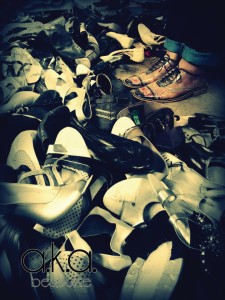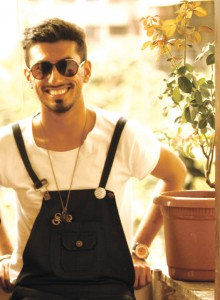When he started creating designs for his own joy, he was a commerce student preparing to take the Common Entrance Test for admission into an MBA programme. Little did he know that a decade later, he’d be working on building his design brand, a.k.a. bespoke, set up with close friends and fellow designers Ateev Anand and Aimen Jarwala. Karan Berry, designer, consultant and educator, happily went along with being the middle initial in the name, between the two As (their names’ first letters).
The shift to design happened when friends suggested he should give it a shot. He read about design careers in the education supplement of a national daily, which helped him zero-in on the college he wanted to study at. The three years at college opened his eyes to new avenues and transformed him from an introvert to an extrovert. “Students cannot enter a programme with a notion, any notion of doing something or not doing something. They have to have their minds open to absorb whatever comes their way, and that is the true way to learn,” says Berry about the importance of having a larger perspective instead of compartmentalising. This, he adds, would enable them to experience, learn and go through the process in an effortless manner.
Berry was always inclined towards shoes, even as a young student when he hadn’t started designing or sketching. He used to be meticulous with the shoes of the entire family – keeping them clean, taking stains off and storing them well. “I was intrigued with footwear. I still am. I just combined that with design, and I knew this is what I wanted to do eventually.” He came back to Mumbai to start work on his own. Berry thinks that’s one of the best things that happened to him: “The work experience is priceless, and after four years, I found my inclination. I knew where my future lay.” So he went to the London College of Fashion affiliated to University of Arts, London, to study the science of footwear design. “I felt privileged to study there, and to find myself more experienced than the others. I knew that I wanted to bring myself notches above where I was, and that’s what kept feeding my hunger to learn more,” remembers Berry. Even there, he created for himself, and felt elated that the creations were appreciated by the right people. After that, he came back to the market he was most comfortable with, and where he had created a name and a reputation for himself within a small but loyal group of customers. “My principle of creation still remains the same; to design for my own happiness and satisfaction. No matter if it does not see an end of actually being manufactured,” says Berry. A person who can never study enough, Berry enrolled for a course on Indian Aesthetics at the Mumbai University. Here’s what the passionate designer has to say
How to Enter the Field
Since I went through the education route, I wouldn’t call it rocket science. You have to take the exams, go for the interviews and be selected. Otherwise, I feel that a designer should get into the field for the sole purpose of creation. The money will come. Also, there may be colleges that have a great reputation, but don’t lose heart if you do not get into one of them. Every engineer cannot be a product of one of the IITs. So, whichever college you go to, get your basics right. If you have to, falter, but learn from it and move on.
Challenges
There are a few at every step; it depends on how you view them. I could have been bogged down when my admission to a short-term course went awry in London. But I took it in my stride and moved on. Even when we set up our own name, a.k.a. bespoke, all three of us were faced with a double responsibility – to build our brand, but in turn, to create awareness about bespoke designs – shoes made to order. Our survival still depends on this awareness. All three of us entered the venture with passion, and for the first year-and-a-half, we were slapped down by whomever we approached. The easiest thing would be to shut shop, but the thought never crossed our minds. In a nutshell –
• Creating your own market is challenging.
• Prepare to be battered and bashed in the beginning, but learn how to get up after each fall.
• Take up every hurdle with confidence.
• Finance challenges exist in every field; this is no exception.
• Learn to rectify a situation when needed.
• Understand the strengths and weaknesses of your brand.
• Being original is a challenge; take it up and overcome it. Draw inspiration to create, not to rip off.
 Skill Set
Skill Set
To be a designer, you have be sure you have that inherent quality inside to pursue it. For instance, Sheldon Cooper of The Big Bang Theory would have all the technical knowledge required but will not be able to create designs. Apart from that, a few things that come to my mind are:
• Presence of mind – It is required to move ahead, to take your ideas one step forward and to create to the satisfaction of the client as well.
• Acute observation skills – This goes not only for the field, but the entire environment, which would enable you to draw inspiration from a variety of places and things. You shouldn’t allow anything to just pass you by!
• Critical evaluation – Not only should you be able to observe, you should also be able to critically analyse the observation you make. Even if it may sound like an incorrect analysis, at least you made your point one way or the other.
• Precision in skill – Shoe making involves precision, and is difficult. Unlike a piece of clothing, it cannot be altered for size! Once it is wrong, it is wrong. • A capability to make it look good – It is also about karigari.
• An ability to struggle – a.k.a. started in small flat (my parents lent it to me), but soon moved to a commercial space within the city. We are still struggling and still learning, but it is a happy struggle.
• No discrimination in work – We create for anyone who comes along. We’ve made shoes for those with foot deformities as well, there are no restrictions.
• Have your design ethic in place – and never compromise on it. In addition, you need to upgrade your skills and ethics over time. You can’t just create for the heck of it, there has to be a purpose.
• Own up to your work – You have to stand up for every piece you create, and respect it. Even if things go wrong, and you are ashamed of the result, just take it as a mistake and respect the effort behind it. Do not abandon anything.
Opportunities in the Field
One can judge the opportunities available not only from the number of new designers and labels but also from the number of new design schools. A few years ago, hardly anyone had heard of customised shoes for fashion, and yet today, I make them! This thought could go to any length you want to take it to – whatever niches you want to create. From customised clothing, accessories, bags, whatever!
Further avenues are created when experimenting with new material. Like for myself, I could now go a step further to set up my own tannery or weaving centre, the possibilities are limitless. Once you are more open to experimenting, a new market opens up. For instance, I do international bespoke footwear in Indian forms. Like we made bespoke kolhapuris once! The channel is vast, and you can take it as far as you want.
Volume 1 Issue 12






























